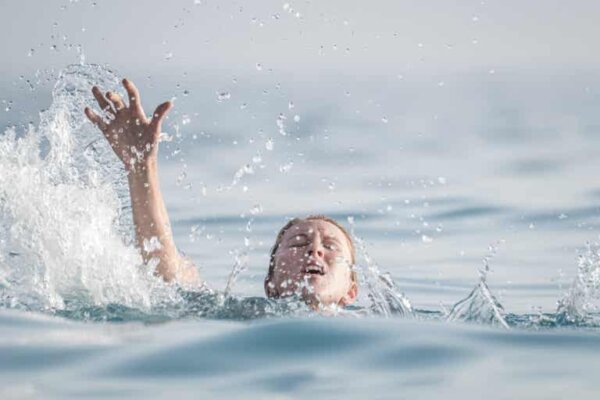Thalassophobia: Fear of the Ocean


Written and verified by the psychologist Elena Sanz
For many of us, the image of a beach with a calm sea is both attractive and relaxing. In fact, few actions are more enjoyable than a swim in the ocean on a hot summer day. However, for those who suffer from thalassophobia, this would prove to be something of a nightmare.
Interestingly, thalassophobia is quite a common disorder. This means that there are many people who experience anxiety and fear, to a certain extent, in the presence of the sea. We ask, where does this phobia come from and what can be done about it?

Thalassophobia
Thalassophobia is a specific phobia characterized by an irrational, excessive and persistent fear of large bodies of water, especially the sea. Those who suffer from it experience true panic in the presence of this type of stimuli or the possibility that they’re nearby. Fear arises even when looking at related images or thinking and imagining them.
Main symptoms
The symptoms are manifested in three main dimensions:
- Physiological. Symptoms such as sweating, palpitations, or shortness of breath appear. Sensations of dizziness, derealization, depersonalization, and somatic pain may also arise.
- Cognitive. There are two main aspects of this kind of fear. There are those who fear being trapped in the water, sinking, or being unable to reach the shore. On the other hand, it’s also possible that the fear is related to uncertainty about what lies below the surface. For example, many people feel that a sea creature might come up from the bottom and attack them.
- Behavioral. The person with thalassophobia will try by all means to avoid any type of contact with these large surfaces of water. This can include the avoidance of images, movies, and any thoughts related to the sea. If it’s not possible for them to stay away, any contact makes them highly uncomfortable, and they try to escape from the situation as soon as possible.
An irrational terror
As in all specific phobias, in thalassophobia, the fear is irrational and doesn’t obey any logic. Obviously, if we fell off a ship in the middle of the ocean, we’d all experience panic. However, those who suffer from thalassophobia feel a similar sensation just by dipping their feet in the sea.
These people are fully aware that in the situation they find themselves in, they can’t drown or be attacked by a sea creature. Nevertheless, they’re unable to control their fear. The anxiety produced is excessive and disproportionate and greatly interferes in their daily lives.
The origin of thalassophobia
Where does this phobia come from? As a matter of fact, the causes aren’t always known and, in most cases, it’s multifactorial in origin. However, it’s common for thalassophobia to arise for the following reasons:
- Traumatic events have been experienced by the sufferer connected to water. For example, perhaps they nearly drowned, or they were trapped in a large body of water with no escape. They could even have lost a loved one in such circumstances. These events can affect anyone at any time of life but are more common during childhood.
- Vicarious conditioning. (observational learning). Witnessing how another person experiences really unpleasant events in the water can cause the appearance of this phobia. It can even happen even if the image comes from fictional movies or series.
- Ignorance of the marine world can also increase fear. That’s because it’s not really clear what the dangers that may appear in a specific place are.

Intervention
To address thalassophobia, it’s necessary to combine techniques that work at different levels. These are the physiological, the cognitive, and the behavioral. It’s common to instruct the sufferer in relaxation techniques to help control their anxiety. On the other hand, it’s about modifying their dysfunctional and catastrophic beliefs and replacing them with others that are more adjusted to reality.
First of all, progressive exposure therapy to the feared stimulus must be conducted. This approach can be done via the imagination, or through virtual or actual reality, the latter being the most effective treatment. With this, the sufferer acquires or discovers the necessary tools to face their fear. Furthermore, they learn that it’s completely unfounded.
All cited sources were thoroughly reviewed by our team to ensure their quality, reliability, currency, and validity. The bibliography of this article was considered reliable and of academic or scientific accuracy.
- Bados, A. y García, E. (2010). La técnica de la reestructuración cognitiva. OMADO. https://diposit.ub.edu/dspace/handle/2445/12302
- Capafons, J. I. (2001). Tratamientos psicológicos eficaces para las fobias específicas. Psicothema, 13(3), 447-452. https://reunido.uniovi.es/index.php/PST/article/view/7898
- Mayo Clinic. (2023). Specific phobias. Consultado el 1 de febrero de 2024. https://www.mayoclinic.org/diseases-conditions/specific-phobias/symptoms-causes/syc-20355156
- Eaton, W. W., Bienvenu, O. J., & Miloyan, B. (2018). Specific phobias. The Lancet Psychiatry, 5(8), 678-686. https://www.thelancet.com/journals/lanpsy/article/PIIS2215-0366(18)30169-X/fulltext
- Van Houtem, C. M. H. H., Laine, M. L., Boomsma, D. I., Ligthart, L., Van Wijk, A. J., & De Jongh, A. (2013). A review and meta-analysis of the heritability of specific phobia subtypes and corresponding fears. Journal of Anxiety Disorders, 27(4), 379-388. https://pubmed.ncbi.nlm.nih.gov/23774007/
- Medina, G. E. (2023). Animales marinos: características, tipos y ejemplos. Mis animales. Consultado el 6 de febrero de 2023. https://misanimales.com/animales-marinos-caracteristicas-tipos-y-ejemplos/
- Association, A. P. (2013). Diagnostic and Statistical Manual of Mental Disorders (DSM-5®). American Psychiatric Publishing.
This text is provided for informational purposes only and does not replace consultation with a professional. If in doubt, consult your specialist.








